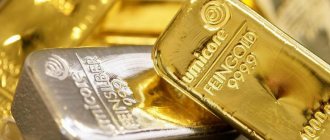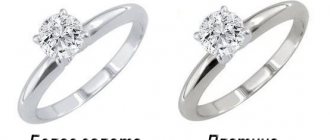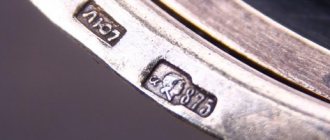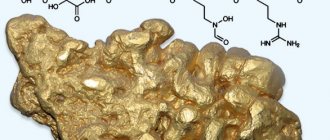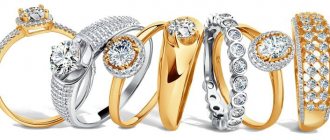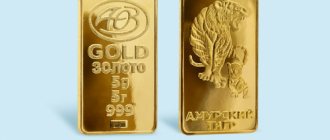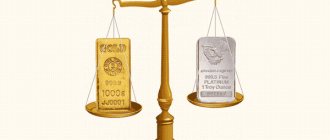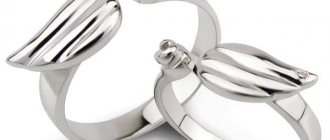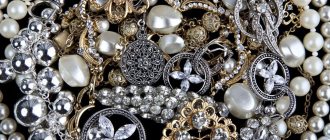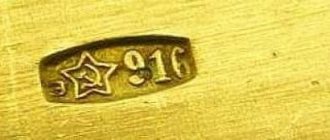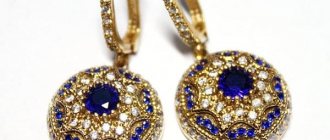Today, there are four precious metals that are widely used in the jewelry business. These are gold, silver, platinum and palladium. All of them were discovered at different times and under different circumstances, however, they are valued by jewelers for their properties that make them ideal for creating jewelry. Let's talk a little about the history of these metals and their characteristics to understand why they are highly valued.
*Read the article “For the first time in 16 years, the value of palladium exceeded the value of gold”*
Gold
Today, gold is considered not only the most precious, but also the “oldest” metal. The first reliable evidence of the use of gold was found in Ancient Egypt and dates back to 3000 BC. Gold has always played a central role in the culture and mythology of various civilizations. For example, in Ancient Egypt it was revered as the metal of the gods, the ancient Greeks considered gold a metal of social status and wealth, and the kingdom of Lydia first began to use it as a currency.
Already in ancient times, people realized that properties such as corrosion resistance, malleability, ductility and luster make gold ideal for creating jewelry. However, people who belonged only to the highest ranks could own it. Today, gold is valued as highly as it was many, many centuries ago, but with the difference that in modern society it has become available to everyone thanks to various samples, or rather due to the alloys used, which significantly reduces its cost.
“It was the biggest crisis in history”
— How do you see the situation in the automobile market, on which the sale of your metal depends?
— The pandemic hit car production quite painfully in 2022. For some companies, monthly car production fell by 70%. In our understanding, this was the largest crisis in history. In the pre-crisis year 2022, the world produced 92 million cars, in 2022 - only 75 million. In 2022, we initially expected that there would be a recovery, but, unfortunately, the pandemic was replaced by another negative factor - a shortage of electronic components and chips. Therefore, the forecast was repeatedly revised downward. The current consensus is 76 million, which is not much different from last year.
Material on the topic
Now we expect that in 2022 the automobile market will recover, although probably not completely, not to the level of 2022. The shortage of electronic chips has essentially severely limited car production. The modern car is packed with electronics, and we see some car companies even reducing the number of available features for customers to save on electronic components.
Silver
The history of silver is as long as the history of gold. Since ancient times, silver has been used to mint coins. It is curious that at some point in their history, Ancient Egypt and Ancient Greece valued silver more than gold, and silver jewelry and cutlery were truly luxury items. For a long time, silver was the basis of the monetary system of Great Britain and the United States of America.
Silver is a noble, ductile and malleable metal that has a relatively low melting point (962 degrees), which makes it especially popular among jewelers. Silver, like gold, is not subject to corrosion and retains its impeccable appearance for centuries. Thanks to the skillful work of jewelers and the inclusion of precious stones, silver items not only do not decrease their value over time, but often increase it.
Try
Since palladium is a soft metal, it is not used in its pure form. Such an alloy will not be able to withstand even slight external influences.
Jewelers use minerals with various impurities for their work. The sample size of the alloy also depends on their number and name.
The main samples of palladium are presented in the table.
| Try | Compound |
| 500 | The alloy contains 50% silver or nickel. |
| 850 | About 15% is silver, nickel or copper. |
| 950 | The composition contains about 5% ruthenium, copper or nickel. |
All metals impart hardness to the element. And if you add gold or silver, you can increase the wear resistance of the alloy.
Platinum
Platinum is one of the most expensive metals on the planet. However, its value was not immediately recognized. The metal was discovered in the 16th century in Colombia by Spanish conquistadors. The conquerors discovered unknown impurities in platinum and mistook it for low-quality silver. Then the Spanish king, fearing that the status of a “golden power” would be irretrievably lost, ordered all the platinum to be drowned. Only 50 years later, when the possibility of processing it became possible, the metal was appreciated and stood on a par with gold.
According to its properties, platinum is twice as dense as gold and has a high level of corrosion resistance, much higher. During the research, metals with similar physical and chemical properties were discovered, one of which is palladium. In addition, palladium and platinum are included in the alloy of white gold and directly determine its value.
Precious metals in economics
Noble and precious metals have served as a means of payment since ancient times. Money was even made from them, but later this practice became obsolete. Nevertheless, in the modern financial system these materials continue to play a leading role. It is a powerful financial instrument that is the basis of the economy. This state of affairs is explained by several factors:
- Gold and silver were the first world currencies that made it possible to carry out commodity-money relations. The value of the very first coins did not depend on where and by whom they were minted. The main role was played by the quality of the metal, as well as its weight parameters, which determined the value of the currency.
- Even at a time when silver coins have long sunk into oblivion, this and other metals are still considered the basis of the state's prosperity. The amount of cash is strictly regulated by the amount of gold in reserve. The metal is also an excellent investment as it constantly increases in value.
However, precious metals have such an undeniable disadvantage as the ability to wear out over the years, albeit slightly. But traders found a way out here too. Trading does not take place using real metal bars, but through the sale of special securities.
Palladium
The youngest metal from the noble family of Palladium, Gold, Platinum and Silver. It was discovered only in 1803 by the English chemist William Wollaston by combining raw platinum with aqua regia and adding mercuric cyanide. The unusual discovery of the precious metal was highly appreciated by his contemporaries.
The main value of this metal lies in its chemical properties: palladium at ordinary temperatures is not affected by hydrochloric acid, fluorine, or aqua regia. It does not fade in air, cracks and scratches do not form on it. The metal is distinguished by its enviable strength and, at the same time, is easily forged, welded and machined, which makes it popular not only in jewelry, but also in medicine and aircraft construction.
However, unlike its famous brother platinum, palladium is less known to the general public, and therefore remains in the shadows. It is undeservedly underestimated everywhere, although its properties are in no way inferior, and in some places it even surpasses not only platinum, but also its other brothers. By the way, the cost of palladium for the first time in 16 years exceeded the cost of gold and is still not losing ground (read the article here).
This brings us to the end of our short excursion into the history and properties of four precious metals. We hope that this article was not only interesting, but also useful for you in the future selection of jewelry.
Besides gold and platinum: top 5 most expensive metals and where they are mined
Iridium
Iridium is a chemical element with atomic number 77 in the periodic table of chemical elements. It is one of the rarest metals in the earth's crust, with annual production of only three tons. The density of iridium is comparable to osmium. In addition, it is the most corrosion-resistant metal element, resistant to air, water, salts and acids.
The history of the discovery of this substance is somewhat prosaic. Iridium was discovered along with osmium during the process of obtaining platinum by refining. The scientist who made this discovery, Tennant, was delighted with the beauty of the picture created by Iridium salts - the “rainbow”. This is how the name of this chemical element was born.
Pure metal is not toxic, but is capable of reacting to form toxic substances, for example, IrF6 fluoride.
- What is the price?
Iridium, one of the rarest precious metals found as a byproduct of platinum and palladium mining, has risen in price by 131% since the beginning of this year, Bloomberg reports. That's much more than Bitcoin, which has risen 85% since January.
Now iridium costs three times more than gold - $6,000 per ounce. It is used to produce premium spark plugs and in electronics. The price of the metal is rising due to supply disruptions last year and strong demand.
Due to the sharp rise in price, iridium has become an attractive asset for investors, the agency notes. However, buying it is not so easy - the metal is not traded on an exchange or through exchange-traded funds. Investors have to contact producers directly and buy iridium in ingots or repurchase it at a higher price.
Along with iridium, demand for other rare platinum group metals has also increased.
Like other PGMs, iridium is mined as a by-product of nickel production. The largest iridium deposits are located in South Africa and Russia.
- How is it used?
Because of its hardness, iridium is difficult to transform into usable parts. However, those characteristics that make it difficult to work with make it a valuable additive for strengthening alloys. Although it is a catalytic metal, its high melting point and resistance to corrosion make iridium the material of choice for crucibles.
When found in nature, the chemical element Ir is accompanied by its natural isotopes. These are stable 191 and 193. However, there is a whole network of synthesized isotopes that have a short half-life. Of these, the most notable is the relatively stable (lifetime 241 years) Iridium 192, which has an isomer Ir 192 with a half-life of 74 days.
The first of them can act as a source of electricity. The second is used as an indicator of the quality of welds. Gamma flaw detectors are equipped with isotope 192.
Since the metal's strength is comparable to its companion Osmium, the material can replace the latter in almost all areas. It is used for the manufacture of thermocouples, fuel tanks, thermoelectric generators.
The alloy of platinum and Ir, even without copper, is known for its high strength; talk that it was previously used to make nibs for pens is true, but similar products were made from an alloy of platinum and osmium. Unlike the latter, iridium is happily used for alloys with platinum by jewelers. Although it is refractory, it still allows you to obtain the necessary forms and put a mark.
Primary deposits of osmic iridium are located mainly in peridotite serpentinites of folded regions (South Africa, Canada, Russia, USA, New Guinea).
Rhodium
Rhodium is relatively unknown to people outside the metallurgical industry.
Rhodium (Rh) is an element of the ninth group (in the old system - a side subgroup of the eighth group) of the fifth period of the periodic table of chemical elements, atomic number - 45. The simple substance rhodium is a solid transition metal of a silvery-white color. A noble metal of the platinum group.
Discovered in England in 1803 by William Hyde Wollaston while working with native platinum. In 1804, William Wollaston reported to the Royal Society that he had discovered new previously unknown metals - palladium and rhodium - in platinum ore from South America. In an effort to purify the “raw” platinum isolated from ore from impurities of gold and mercury, he dissolved it in aqua regia and then precipitated it from the solution with ammonia. The remaining solution had a pink tint, which could not be explained by the presence of then-known impurities. The addition of zinc to this solution resulted in the formation of a black precipitate, which included other metals such as copper, lead, palladium and rhodium. Dilute nitric acid dissolved everything except palladium and rhodium.
- What is the price?
Now the price of rhodium is 68,573 rubles per gram.
Part of the reason for the metal's high price is its rarity. The annual production of rhodium is about 30 tons. By comparison, gold mining companies excavate between 2,500 and 3,000 tons of the precious metal annually. With stricter emissions regulations in major countries including China and India, platinum group metal (PGM) miners are expecting good times for rhodium.
Author: Alchemist-hp (talk) www.pse-mendelejew.dederivative work: Purpy Pupple (talk) - own work, CC BY-SA 3.0
It is worth noting that rhodium is subject to the largest price fluctuations of all precious metals - its price has changed hundreds of times over the past half century. In February 2006, rhodium prices reached a record high of $3,500 per troy ounce. In January 2008, rhodium prices set a new record of $7,000 per ounce. After peaking at $10,100 per ounce, the price of rhodium fell to $900 at the end of November 2008 due to the crisis in the automotive industry. On November 19, 2009, the price of the metal rose to $2,600 per ounce.
As of September 2015, the average price for rhodium is $756.67 per ounce.
The lowest price in recent years for rhodium was observed in August 2016 and amounted to $625 per ounce, after which the price of the metal has been steadily growing. At the end of January 2022, the price reached a record $10,165 ounce. On February 20, 2022, the price per ounce exceeded $20 thousand. At the end of March, rhodium reached a record $29.8 thousand per ounce.
- How is it used?
Rhodium is used in catalytic converters, which are part of automobile exhaust systems. According to S&P Global Platts, nearly 80% of the demand for rhodium and palladium comes from the global automotive industry. 80% of all rhodium is mined in South Africa. Rhodium is also used as a catalyst in various reactions, for example, in the production of acetic acid from methyl alcohol. And an alloy of rhodium with platinum is a very effective catalyst for the production of nitric acid by the oxidation of ammonia with air; there is no economically justified alternative to its use.
Rhodium detectors are also used in nuclear reactors to measure neutron flux.
In the production of glass products (platinum-rhodium alloy is used in the manufacture of dies for drawing glass filaments), as well as liquid crystal screens. Due to the growth in the production of liquid crystal devices, the consumption of rhodium is growing rapidly: in 2003, 0.81 tons of rhodium were used in glass production, in 2005 - 1.55 tons of rhodium.
Rhodium metal is used to produce mirrors for high-power laser systems that are subject to intense heating (for example, hydrogen fluoride lasers), as well as for the production of diffraction gratings for devices for analyzing matter - spectrometers.
Platinum-rhodium alloy crucibles are used in laboratory research and also for growing some gemstones and electro-optical crystals.
The largest producer of rhodium is the Republic of South Africa - it accounts for 80% of production. This precious metal is also mined in Zimbabwe, North America, Russia and other countries.
Palladium
Palladium is a chemical element with atomic number 46. It belongs to the 10th group of the periodic table of chemical elements (according to the outdated short form of the periodic system, it belongs to a secondary subgroup of group VIII, or group VIIIB), and is located in the fifth period of the table. The atomic mass of the element is 106.42(1) a. e.m. Denoted by the symbol Pd.
Author: Juri
The element belongs to the transition metals and noble metals of the platinum group (light platinoids). The simple substance palladium under normal conditions is a ductile metal of silvery-white color.
- What is the price?
Now the price of palladium is only growing and amounts to 6,415 rubles per gram.
Palladium is the most expensive of the four main precious metals: gold, silver and platinum. It is less common than platinum and is used in large quantities in catalytic converters.
The Russian miner is the world's largest palladium miner, producing 86 metric tons in 2022.
- How is it used?
Palladium is needed most in the automotive industry. Like platinum, this metal is used in catalytic converters (catalysts), which convert harmful hydrocarbons, nitrogen oxides and other chemical compounds contained in exhaust gases into relatively harmless carbon monoxide and water vapor. In fact, palladium and platinum act like a sponge, absorbing hydrocarbons. Palladium is capable of absorbing 900 times its own weight in exhaust.
Platinum is used in catalysts for diesel cars, palladium in gasoline ones. The main demand in Europe since the 1990s has been for diesel engines, as they are more environmentally friendly.
Accordingly, platinum autocatalysts were more in demand than palladium ones, which was reflected in the market price of metals: platinum cost about a thousand dollars per ounce, palladium - about 200.
Medical instruments, parts of pacemakers, and dentures are made from palladium and its alloys. In some countries, a small amount of palladium is used to obtain cytostatic drugs - in the form of complex compounds, similar to cis-platinum. Beta-active palladium-103 is used for brachytherapy in the treatment of cancer.
The largest palladium deposit is located in Russia (Norilsk, Talnakh). Deposits are also known in the Transvaal (South Africa), Canada, Alaska, Australia, and Colombia. Supplies of palladium in the world in 2007 amounted to 267 tons (including Russia - 141 tons, South Africa - 86 tons, USA and Canada - 31 tons, other countries - 9 tons).
Gold
Gold (Au from the Latin Aurum) is an element of group 11, the sixth period of the periodic table of chemical elements, with atomic number 79. The simple substance gold is a noble metal of yellow color.
Part durability, part tradition, gold is one of the most versatile commodities. Primarily used in jewelry, but also has important applications in electronics and aerospace due to its strength and conductivity. Simply put, gold is used everywhere.
- How is it used?
In the modern world, gold is used not only as a precious metal to provide currency and create expensive jewelry. Gold is also an important raw material that is used in many industrial sectors. At the same time, the demand for industrial gold is several hundred tons per year.
The main consumer of gold is the electronics industry, which uses it in electronic components for computers and mobile phones. And the electronics sector's gold consumption is only expected to increase, fueled by the growth of the electronic components industry.
Next in gold consumption is dentistry; many dentures and crowns contain this material, but now the market for dental gold is on the contrary declining. This is due to the fact that more reliable and modern materials are now used, the quality of which is superior to gold products.
Author: Periodictableru - own work (www.periodictable.ru), CC BY 3.0
The chemical industry is in third place in the use of gold; it is used to apply protective coatings to chemical equipment, which prevents the formation of corrosion. It is also used as a catalyst in many chemical reactions.
In last place is the use of gold in small industry and household consumption: applying protective coatings, gilding watch cases, making fabrics with gold threads, creating special types of glass, etc.
The uses of gold are very extensive. The areas of its use include spacecraft engines, gold jewelry, any electronics, fabrics, glass, chemistry, medicine and much more. Gold as a precious metal has retained its investment, industrial, jewelry and medical purposes for several millennia. This trend is unlikely to be interrupted in the future; the properties of the yellow metal will always be used by scientists, expanding the boundaries of its modern use.
- What is the price?
Now the price of gold is 4,208 rubles per gram.
Of course, the stereotype of gold as a prestigious and valuable metal did not arise out of nowhere. When Spanish explorers first traveled to the “New World” of America, they encountered an indigenous culture that lived completely different lives and spoke different languages. But both cultures had one thing in common; both valued gold highly. Almost every society has used it as currency and a symbol of wealth, prestige or power, and the modern world is no exception. Whether it's wedding rings, awards or even money, few substances occupy as important a place in our lives as gold.
Until the 1970s, South Africa was the dominant gold producer, but production has declined since then. At its peak in 1970, it produced 32 million ounces of gold, accounting for two-thirds of global production of the metal. Today, China, Australia and Russia are among the three leaders in its production.
Platinum
Platinum is a chemical element of the 10th group, 6th period of the periodic table of chemical elements with atomic number 78; shiny noble metal of silver-white color.
- How is it used?
Platinum is primarily used in catalytic converters for diesel vehicles—45% of platinum sold in 2014 went to the automotive industry.
Everyone knows that platinum is used to create jewelry, because the metal has high levels of hardness and ductility. In addition, platinum products delight with their appearance: silver color and characteristic shine make jewelry very popular among buyers.
Until the middle of the last century, only a few percent of the mined precious metal was allocated for the medical field. But today the situation has changed, and the demand for platinum is growing exponentially. This is most likely due to the development of research that has revealed the advantages of platinum over other metals.
Today, platinum is needed in the following areas of life:
- space industry
; - medicine
; - electrical engineering
; - glass industry
; - production of aircraft and ships
; - chemical industry
.
Platinum has also been used in banking. This precious metal is an investment item: ingots are cast from it.
Platinum is needed in the production of nitric acid
and other chemicals. In this case, the element acts as a catalyst, accelerating reactions that are too slow. For this purpose, they do not use pure platinum, but its alloy with rhodium. Otherwise, the production of the substances would be too expensive.
The metal also plays the role of a catalyst in oil refining. With its help, gasoline is produced from oil. And if platinum is used in the form of a grid to create nitric acid, then powder is made from it for use in oil processing. Of course, you can use other catalysts, such as aluminum or molybdenum, but platinum is more durable and efficient.
Author: Periodictableru - own work, CC BY 3.0
Use of platinum in electrical engineering
due to stable electrical and mechanical properties. The material conducts current well and also has a decent thermal conductivity. Typically, platinum alloys are used to make contacts, and combining platinum with cobalt makes it possible to create powerful magnets.
Application of platinum in the medical industry
helps save the lives of thousands of sick people. The fact is that there are simply no analogues to this material. Products made from other metals are not resistant to oxidation and are therefore not suitable for such a reaction.
In the field, platinum instruments are sterilized in the flame of an alcohol burner.
Platinum is also often used to create implants for people with hearing impairments. In addition, there is an opinion that this material helps fight cancer. Many drugs are made based on this metal to help people overcome cancer.
- What is the price?
Now the price of gold is 2,827 rubles per gram.
Platinum has traditionally sold for a higher price than gold, and coupled with its rarity compared to gold, "platinum" as an adjective has come to be associated with a higher level of prestige than gold. Despite the problems with platinum and gold, which is now trading above it, this reputation remains.
In total, the world produces an average of about 2,500 tons of gold per year. The largest amount of gold in the world is mined in South Africa. This is followed by China, Australia, the USA, Peru, Russia (in sixth place), Canada, Mali, Uzbekistan, and Ghana. In 2010, more than 450 tons of gold were used in the world for technical purposes.
Read more
Ideal conditions for the origin of life have been found on Saturn's moon
Oxygen will definitely disappear: what will happen to the Earth without the main source of life
Physicists have created an analogue of a black hole and confirmed Hawking's theory. Where it leads?
Troy ounce is a unit of mass equal to 31.1034768 grams.
How the cost of precious metals is formed
All types of noble metals are distinguished by the fact that their reserves in nature are extremely limited. In addition, compared to other substances, they are quite expensive. When determining the price of precious metals, a number of factors must be taken into account:
- Supply and demand in the market. In accordance with economic laws, the higher the demand for a particular product (in this case, a precious metal), the more its price will increase. If we talk about the proposal, then it acts in the diametrically opposite way. So, if metal production increases sharply, its value will immediately collapse.
- State funds. Since almost all countries use precious metals as a reserve, they can regulate the market situation in a certain way. Thus, by putting up part of its reserves for auction (intentionally or forcedly), the government will contribute to a sharp reduction in the price of this product. If a decision is made to replenish reserves, the opposite situation will arise.
- Method and scale of production. It is worth noting that the cost of precious metals largely depends on how and in what place it is mined. So, if we talk about third world countries, where labor is very cheap, then the cost of raw materials will be simply insignificant compared to the price that the final buyer will pay.
What is marking for and how is it applied?
Precious metals are a marker of wealth and status. To distinguish them from iron and other “common people”, each product is marked with a special sign.
Branding and marking of precious metals
This is also required by law: products made of precious metals must be marked.
Brand as a guarantee
A brand is not just a “decoration”:
- This is a state hallmark.
- Only products that meet national quality standards are branded.
- The absence of a mark indicates: jewelry made of precious stones and metals; another product has not passed state inspection. The composition can be anything.
The second element of product marking is the manufacturer’s logo imprint.
How to apply
The method of applying a mark (branding) is selected based on the configuration of the product:
- Mechanical. The most common. Previously, the stamp template was stamped with a hammer. Today the procedure is entrusted to an automatic machine.
- Electroerosive. The brand is burned out by a spark. Used for hollow, openwork products.
- Laser. The outline of the mark is created with a laser. The best option for embossed hollow products.
The last branding method is the most difficult to counterfeit.
Stamp structure
The description of the mark includes three parameters:
- Code of the State Inspectorate of Assay Supervision . A letter of the Russian alphabet (each region of the Russian Federation has its own).
- Try. A three-digit number indicating the content of precious metals in an alloy. That is, how many mg of pure precious metal does 1 g of a particular product contain.
- Identity card image . A hammer with a sickle in the center of a five-pointed star or a profile of a woman’s head in a kokoshnik facing to the right.
Hallmarks of Precious Metals
The shape of a hallmark also helps to read it correctly.
This is a stylized image of the item:
- gold – spatula;
- silver - barrel;
- platinum - octagonal;
- palladium - a cone with a cut off top.
In Russia, the Cyrillic alphabet is used to designate precious metals and materials containing them: Zl, Pl, Sr, Pd, Rd, Ir, Ru, Os . For example, the designation PdRu 94-6 denotes a palladium-ruthenium alloy.
The quantitatively dominant element is placed first in the alloy marking.
Branding in various fields
The hallmark is useful not only for jewelers:
- For metallurgy, this is information about the composition of alloys with precious metals as alloys.
- Financiers evaluate precious metals as a commodity, a means of investment.
- Numismatists use it as a guide when evaluating coins.
Platinoids are added to alloys of noble metals in order to “tighten” the utilitarian characteristics (hardness, ductility, color) to the specified parameters.
How to distinguish white gold from silver
It is often difficult to distinguish white metal products by appearance, since rhodium-plated silver will shine no worse than gold. If you have something to compare with, you can “weigh” the jewelry in your hand - the silver will be much lighter. Visually, gold has a cooler shine and a matte surface. You can reliably distinguish metal only by the mark, which is located on the inside of the product.
Experts suggest methods using iodine or acid, but it is unlikely that anyone in a jewelry store will allow such experiments. If in doubt, you should contact a jeweler.
Which metal jewelry is best to choose?
When choosing something to wear constantly, you should give preference to the material that has the best physical properties.
Platinum jewelry is stronger, it will last longer, and there will be no scratches on the surface. In addition, such products will not cause allergies. They are much more expensive and belong to the premium segment. Gold jewelry is a relatively inexpensive option, but it will delight you for many years.
Recommendations for care, cleaning and storage
White gold is a rather capricious material; it should be protected from chlorine-containing substances and abrasive pastes. You should not wear jewelry in the pool, sauna, or while doing housework. Platinum items may become dull over time, but this has nothing to do with how they are used. To update the appearance, both gold and platinum jewelry are rhodium-plated in a jewelry workshop.
Processing of precious metals
While admiring beautiful jewelry, few people think about what procedures the metal went through to turn into an elegant thing. There are a number of techniques and methods by which precious substances are processed:
- forging - involves stretching and shaping metal using special tools;
- casting - involves the manufacture of certain products by filling molds with molten raw materials;
- carving - involves removing part of the metal from the surface of the product to create a pattern or relief;
- embossing is the process of giving metal three-dimensional shapes by striking it with a hard object;
- basma - an image of certain motifs or patterns on an ultra-thin sheet of one or another precious metal;
- filigree - is a pattern formed by soldering thin wire onto a base sheet;
- solder - used to firmly connect individual elements of the product to each other (an important feature of this technique is that the joints are completely invisible);
- niello - giving individual elements of a product a darker shade by combining the base with an alloy of silver, sulfur, copper and lead, which has a pronounced dark shade;
- enamel - coating of the elements of a substance with a colored composition, its liquid structure reminiscent of glass (the enamel acquires strength and opacity after treatment at high temperatures).
How are precious metals mined?
Gold was one of the first metals that man discovered. Historians say that when ancient people found nuggets, they simply made holes in them and wore them around their necks. And since the metal was quite pure, it could easily be given absolutely any shape. Later they began to search for gold purposefully, sifting sand in rivers.
Now it is mined in a completely different way. Gold is extracted from underground deposits. To begin with, the ore is treated with special substances to obtain a solution. Next, it undergoes a filtration procedure, as a result of which the gold is separated from foreign impurities. Mercury can also be used to separate metal from other substances. Next, the gold is sent to refineries, where it is completely purified.
Despite the fact that silver is a relatively cheap material, its nuggets are practically never found in nature. That is why it became known to mankind several centuries later. Underground ore contains only 20% impurities. However, silver is not mined deliberately. It can be considered a by-product of copper and lead processing. Like gold, Ag is also refined in refineries.
Precious metals should not be underestimated, relegating their scope of application only to jewelry. In fact, their use spans many industries where strength and precision are required.
